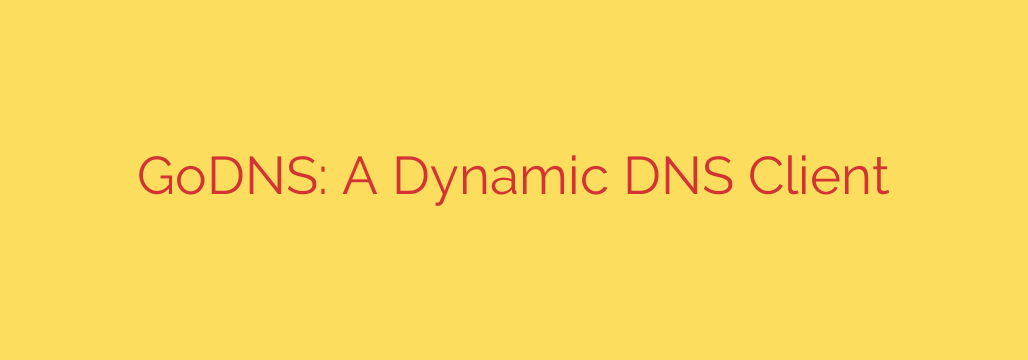
Never Lose Connection: A Deep Dive into GoDNS for Dynamic DNS Management
For anyone running a home server, managing a remote desktop, or self-hosting applications, a dynamic IP address can be a constant source of frustration. Your Internet Service Provider (ISP) often assigns you an IP address that changes without warning, effectively cutting off access to your network until you manually update your records. This is where a Dynamic DNS (DDNS) service becomes essential, and a powerful client like GoDNS is the key to automating the entire process.
A DDNS service bridges the gap between your ever-changing IP address and a static, easy-to-remember domain name. Instead of trying to connect to a string of numbers that might be outdated, you can simply use a hostname like my-home-server.com. The magic happens behind the scenes, where a DDNS client on your network regularly checks your public IP address and, if it has changed, automatically updates your DNS records.
What Makes GoDNS a Superior DDNS Client?
GoDNS is a modern, lightweight, and highly efficient Dynamic DNS client built with the Go programming language. This choice of technology gives it several distinct advantages, making it an ideal tool for both beginners and advanced users. Unlike bulkier applications, GoDNS is delivered as a single, standalone executable file with no complex dependencies, making installation incredibly simple across various platforms.
Whether you’re running a powerful server or a low-powered device like a Raspberry Pi, GoDNS provides a reliable solution without consuming significant system resources.
Core Features That Set GoDNS Apart
Understanding the capabilities of GoDNS reveals why it has become a go-to choice for managing dynamic IP addresses.
Extensive Provider Support: One of the biggest strengths of GoDNS is its compatibility with a wide array of popular DNS providers. It seamlessly integrates with services like Cloudflare, GoDaddy, Namecheap, DuckDNS, Google Domains, and many others. This flexibility means you can likely use it with your existing domain registrar without needing to switch services.
Cross-Platform Compatibility: Because it’s written in Go, GoDNS can be compiled to run natively on nearly any operating system. It works flawlessly on Windows, macOS, Linux, and ARM-based systems like the Raspberry Pi, ensuring you can deploy it on whichever device is most convenient.
Support for Both IPv4 and IPv6: As the internet continues its transition to IPv6, having a tool that can manage both types of addresses is crucial. GoDNS can monitor and update A records (for IPv4) and AAAA records (for IPv6) simultaneously, future-proofing your network setup.
Simple and Clear Configuration: Getting started with GoDNS is straightforward. All settings are managed through a single, human-readable configuration file (typically in JSON format). In this file, you simply specify your DNS provider, enter your API credentials, and list the domains you want to keep updated.
Lightweight and Efficient: The client is designed to be lean. It performs its checks periodically and only communicates with your DNS provider when an IP change is detected. This minimal resource footprint makes it perfect for “always-on” devices where performance and efficiency are paramount.
Actionable Security Tip: Protect Your Credentials
When configuring GoDNS, you will need to provide it with API keys or tokens from your DNS provider. These credentials grant the application permission to modify your DNS records and must be protected.
Never hardcode your API keys directly into scripts that might be publicly shared or stored in an insecure location. Instead, use a secure configuration file and ensure its file permissions are restricted so that only the necessary user account can read it. On Linux or macOS, you can use a command like chmod 600 config.json to lock down access. This simple step is critical for maintaining the security of your domain.
Getting Started with GoDNS
Setting up GoDNS is a simple, three-step process:
- Download: Obtain the pre-compiled binary for your specific operating system and architecture.
- Configure: Create your configuration file, adding your provider details, API key, and the domain(s) to monitor.
- Run: Execute the program. For continuous operation, it’s best to run it as a system service or using a tool like
cron(on Linux) or Task Scheduler (on Windows) to ensure it runs automatically on startup and stays active.
By automating your DNS updates with a reliable client, you can ensure consistent, uninterrupted access to your home network and services. GoDNS stands out as a powerful, flexible, and secure solution that simplifies this essential task, allowing you to focus on your projects without worrying about a changing IP address again.
Source: https://www.linuxlinks.com/godns-dynamic-dns-ddns-client-tool/








